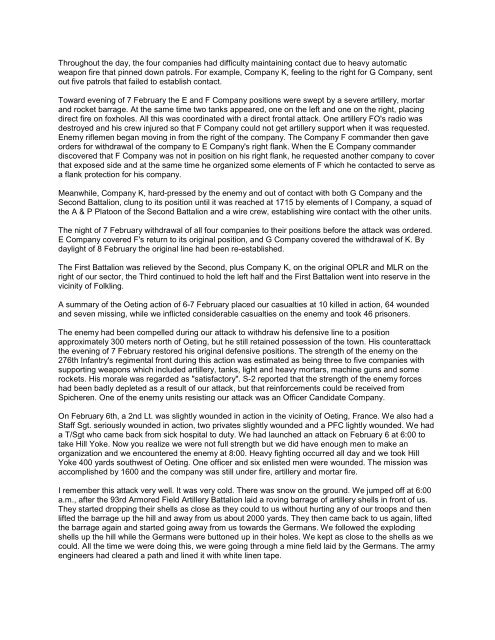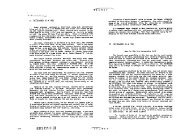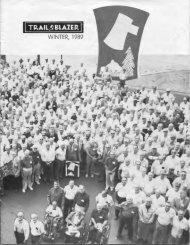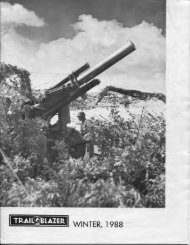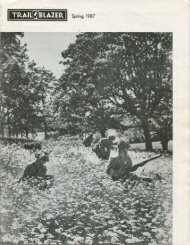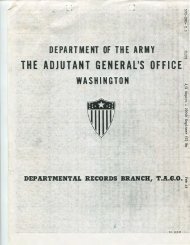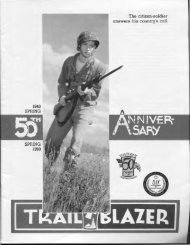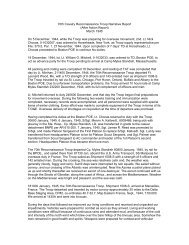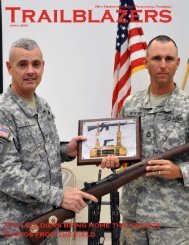Download - 70th Infantry Division Association
Download - 70th Infantry Division Association
Download - 70th Infantry Division Association
Create successful ePaper yourself
Turn your PDF publications into a flip-book with our unique Google optimized e-Paper software.
Throughout the day, the four companies had difficulty maintaining contact due to heavy automatic<br />
weapon fire that pinned down patrols. For example, Company K, feeling to the right for G Company, sent<br />
out five patrols that failed to establish contact.<br />
Toward evening of 7 February the E and F Company positions were swept by a severe artillery, mortar<br />
and rocket barrage. At the same time two tanks appeared, one on the left and one on the right, placing<br />
direct fire on foxholes. All this was coordinated with a direct frontal attack. One artillery FO's radio was<br />
destroyed and his crew injured so that F Company could not get artillery support when it was requested.<br />
Enemy riflemen began moving in from the right of the company. The Company F commander then gave<br />
orders for withdrawal of the company to E Company's right flank. When the E Company commander<br />
discovered that F Company was not in position on his right flank, he requested another company to cover<br />
that exposed side and at the same time he organized some elements of F which he contacted to serve as<br />
a flank protection for his company.<br />
Meanwhile, Company K, hard-pressed by the enemy and out of contact with both G Company and the<br />
Second Battalion, clung to its position until it was reached at 1715 by elements of I Company, a squad of<br />
the A & P Platoon of the Second Battalion and a wire crew, establishing wire contact with the other units.<br />
The night of 7 February withdrawal of all four companies to their positions before the attack was ordered.<br />
E Company covered F's return to its original position, and G Company covered the withdrawal of K. By<br />
daylight of 8 February the original line had been re-established.<br />
The First Battalion was relieved by the Second, plus Company K, on the original OPLR and MLR on the<br />
right of our sector, the Third continued to hold the left half and the First Battalion went into reserve in the<br />
vicinity of Folkling.<br />
A summary of the Oeting action of 6-7 February placed our casualties at 10 killed in action, 64 wounded<br />
and seven missing, while we inflicted considerable casualties on the enemy and took 46 prisoners.<br />
The enemy had been compelled during our attack to withdraw his defensive line to a position<br />
approximately 300 meters north of Oeting, but he still retained possession of the town. His counterattack<br />
the evening of 7 February restored his original defensive positions. The strength of the enemy on the<br />
276th <strong>Infantry</strong>'s regimental front during this action was estimated as being three to five companies with<br />
supporting weapons which included artillery, tanks, light and heavy mortars, machine guns and some<br />
rockets. His morale was regarded as "satisfactory". S-2 reported that the strength of the enemy forces<br />
had been badly depleted as a result of our attack, but that reinforcements could be received from<br />
Spicheren. One of the enemy units resisting our attack was an Officer Candidate Company.<br />
On February 6th, a 2nd Lt. was slightly wounded in action in the vicinity of Oeting, France. We also had a<br />
Staff Sgt. seriously wounded in action, two privates slightly wounded and a PFC lightly wounded. We had<br />
a T/Sgt who came back from sick hospital to duty. We had launched an attack on February 6 at 6:00 to<br />
take Hill Yoke. Now you realize we were not full strength but we did have enough men to make an<br />
organization and we encountered the enemy at 8:00. Heavy fighting occurred all day and we took Hill<br />
Yoke 400 yards southwest of Oeting. One officer and six enlisted men were wounded. The mission was<br />
accomplished by 1600 and the company was still under fire, artillery and mortar fire.<br />
I remember this attack very well. It was very cold. There was snow on the ground. We jumped off at 6:00<br />
a.m., after the 93rd Armored Field Artillery Battalion laid a roving barrage of artillery shells in front of us.<br />
They started dropping their shells as close as they could to us without hurting any of our troops and then<br />
lifted the barrage up the hill and away from us about 2000 yards. They then came back to us again, lifted<br />
the barrage again and started going away from us towards the Germans. We followed the exploding<br />
shells up the hill while the Germans were buttoned up in their holes. We kept as close to the shells as we<br />
could. All the time we were doing this, we were going through a mine field laid by the Germans. The army<br />
engineers had cleared a path and lined it with white linen tape.


